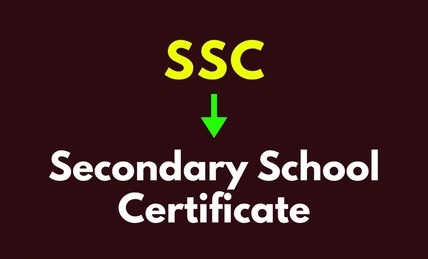The Secondary School Certificate (SSC) typically marks the completion of secondary education and the beginning of more specialized academic or vocational tracks. In most cases, it is a necessary qualification for further education and is often required for employment opportunities.
Applying for the Secondary School Certificate (SSC) involves several steps, from registration to submitting necessary documents and payment. This guide will provide a comprehensive overview of the application process for the Secondary School Certificate (SSC).
SSC Examination System:0
Table of Contents
Before applying, it’s important to know the structure of the SSC examination. The SSC exam typically includes subjects such as:
- Languages (e.g., English, regional languages)
- Mathematics
- Science (Physics, Chemistry, Biology)
- Social Studies (History, Geography, Civics, Economics)
- Optional Subjects (e.g., Computer Science, Arts, Commerce-related subjects)
The examination is conducted by various boards, such as the CBSE (Central Board of Secondary Education), ICSE (Indian Certificate of Secondary Education), State Education Boards, and others, depending on the region.
Eligibility Criteria:
Each board has its specific eligibility criteria for students wishing to appear for the SSC exam. However, the general requirements are:
- Age Limit: The student must typically be between 14 to 16 years of age.
- Education Level: Students must have completed their 9th grade or its equivalent and be enrolled in the 10th grade.
- Attendance: Many boards require a minimum attendance percentage (e.g., 75%) for students to be eligible for the SSC examination.
For students from certain boards like CBSE or ICSE, the minimum academic requirement may include passing internal exams or assessments throughout the year.
Registration Process For Secondary School Certificate (SSC):
The registration process for the SSC exam can generally be divided into two phases: Offline and Online Registration.
Offline Registration (For State or Private Schools):
Visit the School Office: Students need to visit their respective school administration offices. The school usually handles the registration process for SSC students.
Obtain the Registration Form: Schools typically provide the registration form that needs to be filled out. These forms will include personal details, subject choices, and examination preferences.
Fill the Form: Students should carefully fill in their details, including their name, date of birth, and subjects they intend to appear for. Double-check for any spelling mistakes, especially in names.
Submit Required Documents: Along with the registration form, students are required to submit certain documents, which may include:
- Proof of age (Birth certificate)
- Passport-sized photographs
- Address proof
- Previous academic records (if applicable)
Fee Payment: A nominal registration fee is often required. The fee structure varies depending on the board and the number of subjects the student is appearing for. Schools usually guide students on how and where to make the payment.
Receive Acknowledgement: After the submission of documents and fee payment, students will receive a confirmation from the school or examination authority regarding their registration. Keep a copy of the acknowledgment for future reference.
Online Registration (For Some Boards):
Visit the Official Website: For boards like CBSE, students need to visit the official website (e.g., cbse.nic.in) or the designated portal for SSC registration.
Create an Account: If it’s the first time applying, students need to create an account on the board’s official portal by entering their email address and creating a password.
Fill the Online Form: After logging in, students will be required to enter personal details, subjects, school details, and any other information requested.
Upload Documents: Students may need to upload scanned copies of documents such as:
- Passport-sized photographs
- Signature
- Birth certificate
- School transfer certificate (if applicable)
Pay the Fees: Payment is usually done online via credit/debit cards, net banking, or other online modes. The fee amount varies depending on the number of subjects and the board’s guidelines.
Submit and Print: Once the form is complete and the fee is paid, students can submit the registration form online. It’s important to print a copy of the submitted form for future reference.
Selection of Subjects:
Selecting the right combination of subjects is a critical decision during the SSC exam application process. Depending on the board, students can choose from the following:
Core Subjects: Language (English, regional language), Mathematics, Science, and Social Studies.
Optional Subjects: Depending on the student’s interest, they may choose electives like Computer Science, Arts (Fine Arts, Music), Commerce-related subjects (Economics, Accountancy), etc.
Students should consult with their teachers or career counselors before making subject selections. Additionally, some boards or schools may have set combinations of subjects that students must follow.
Admit Card and Hall Ticket:
After the registration is completed and processed, the examination authority will issue an admit card or hall ticket to eligible candidates. This card contains vital information such as:
- Candidate’s name
- Roll number
- Examination center
- Exam timings
- Subject details
Admit cards are generally available online for students who have registered via the official portal, while those who have registered offline can receive it from their schools.
Students should check all the information on the admit card carefully and report any discrepancies to the school or examination authority well in advance. It’s crucial to carry the admit card to the examination center as it is mandatory for entry.
Exam Day and Results:
On the day of the exam, students should arrive at the examination center at least 30 minutes before the scheduled time. Ensure to bring the admit card, stationery (pen, pencil, eraser), and any other required documents.
After completing the exam, the results are typically declared a few weeks later. Students can check their results online by visiting the board’s official website or via SMS.
Conclusion:
The SSC exam is a significant event in a student’s academic journey, and applying for it requires careful planning and adherence to the procedures outlined by the respective examination board. Whether applying online or offline, students should ensure that they complete all steps diligently, choose the right subjects, and be well-prepared for the exam.
